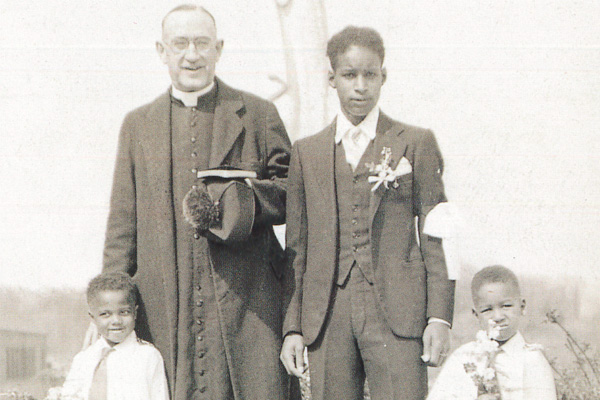
CROWN HEIGHTS — Despite heavy rain, dozens flocked to St. Francis of Assisi-St. Blaise Church, Prospect Lefferts Garden, on Oct. 27 for a Latin Mass for Msgr. Bernard Quinn’s cause for canonization.
At the end of Mass, Msgr. Paul Jervis, the pastor and postulator of Msgr. Quinn’s cause, prayed for the rain to be a “shower of blessings” on the cause for canonization for Msgr. Quinn, who served in the Diocese of Brooklyn in the 1900s. Auxiliary Bishop James Massa celebrated the Mass.
Bishop Nicholas DiMarzio is scheduled to meet with Pope Francis in mid-November, and at that time, the bishop will present the diocesan investigation into Msgr. Quinn’s cause to the Congregation for the Cause of Saints at the Vatican. Next, the congregation will open its own investigation to consider Msgr. Quinn for the title of venerable, the second of four steps on the road to sainthood.
Msgr. Jervis started to push for the cause in the 1980s, when he first served at St. Peter Claver, Bedford-Stuyvesant, which was founded by Msgr. Quinn in 1921 as the first parish in the diocese for black Catholics. He also founded both an orphanage for black children in Wading River, L.I. — which was burned down by the Ku Klux Klan twice before it finally withstood the third time— and St. Benedict Moor, a parish for black Catholics in Jamaica.
Msgr. Quinn also brought thousands of people from all races together for a weekly novena to St. Therese of the Little Flower, a saint he grew fond of while serving as a chaplain in France during World War I.
“You have to understand that he founded a church for blacks, but whites went to that church because he was a priest who loved and cared for them as much as he loved and cared for the blacks,” said Msgr. Jervis.
In 2008 Bishop DiMarzio officially opened the diocesan investigation giving Msgr. Quinn the title “Servant of God,” the first step to sainthood. Msgr. Jervis said there is no specific timeline for the process, but pointed to newly canonized St. John Henry Newman, who wasn’t named a venerable until 100 years after his death as an example of how long the process can take.
There are already a number of people claiming miracles through the intercession of Msgr. Quinn, Msgr. Jarvis said. Miracles verified by the Vatican are the key to reaching the final two steps to canonization.
In his homily at the Latin Mass, Bishop Massa said people don’t have to wait for Msgr. Quinn’s canonization to seek his guidance toward a life-changing encounter with Christ.
“Right now, he is close to us and always ready to pray for us before the throne of our heavenly king,” Bishop Massa said. “May Msgr. Bernard Quinn lead us to Jesus and may Jesus soon reveal to the Church that this priest, this priest of Brooklyn, is indeed in heaven among the saints.”
What’s Next?
The diocesan summary is reviewed by a panel of nine theologians to determine if Msgr. Quinn lived a heroic life. If a majority votes in favor, then cardinals and bishops in the Congregation for Causes of Sainthood evaluate the case before they provide a recommendation to the pope on whether Msgr. Quinn should be declared Venerable.
Source: United States Conference of Catholic Bishops
